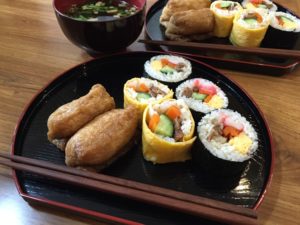Inari & Makizushi

稲荷ずし
Inarizushi (Sushi rice in fried tofu pouches)
The distinctive flavour of this popular morsel comes from the sweet and salty combination of sugar and soy sauce that goes into both the rice and the thin wrapping of fried tofu around it. Sugar used to feature in a lot of Japanese recipes, partly as a preservative in the days before electric refrigeration. Nowadays that role is less important and people tend to reduce the amount of sugar in their inari-zushi, but it is still an essential part of the taste.
I tend to use them along with makizushi (sushi rolled in seaweed or egg strips), whose savory taste contrasts nicely with the sweetness of the inzarizushi.
I’ll show you how to avoid tearing the delicate pouch of fried tofu that goes around the suchi rice and make a nice plump mouthful out of it.
By the way, Inari is the name of the mythical fox-dog that is said to guard rice granaries. The appearance of the inari-zushi is that of a miniature kome-dawara – a large measure of rice (typically 60 kilos) wrapped in straw.
巻きずし
Makizushi (Roll sushi)
Using the same slightly sweet sushi rice (sushimeshi) as for inarizushi, we use a small, flexible bamboo mat called a makisu to role it into a cylinder around the filling, which may include cucumber, carrot, crab-sticks, burdock. Just leave out the crab-sticks for the vegetarian option. Makizushi is usually wrapped in dry seaweed (norimaki), but if you don’t fancy that, a thin strip of thin-fried egg (usuyaki tamago) can substitute (tamagomaki). I sometimes make a few of each for variety.

